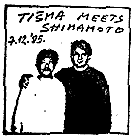Encounter Art
by Andrej Tisma
 Inspiration
is a phenomenon of the spirit, and for that reason can be transmitted,
exchanged and received even without the aid of physical media such as
painting, sculpture, sound, gesture or written text. All that is necessary
for the transmission of inspiration is a spiritual link between two or
more beings. Long-distance telepathy, parallel thought-flow, wordless
dialogue, the "spirit of the times" and morphogenetic fields
of influence--all these are familiar elements of everyday life and experience,
even though science, despite intensive work on the subject, has not yet
succeeded in understanding them completely. Art, which has always been
ahead of science as far as recognizing new human paradigms is concerned,
makes use of these phenomena on an equal basis along with other means
of expression.
Inspiration
is a phenomenon of the spirit, and for that reason can be transmitted,
exchanged and received even without the aid of physical media such as
painting, sculpture, sound, gesture or written text. All that is necessary
for the transmission of inspiration is a spiritual link between two or
more beings. Long-distance telepathy, parallel thought-flow, wordless
dialogue, the "spirit of the times" and morphogenetic fields
of influence--all these are familiar elements of everyday life and experience,
even though science, despite intensive work on the subject, has not yet
succeeded in understanding them completely. Art, which has always been
ahead of science as far as recognizing new human paradigms is concerned,
makes use of these phenomena on an equal basis along with other means
of expression.
Encounter art is one of those forms of artistic activity which leads to a direct exchange of inspiration among spiritually awakened beings: either among artists themselves or through direct contact between the artist and audience.
It
is possible to follow developments in non-material art forms--whether
they be encounters, dialogues, interaction or spiritual exchange--starting
in the late 1950s with the advent of "Happenings", a form in
which the artist's spontaneous, unplanned actions involve the
audience. This was followed by the Fluxus movement, which spilled over
into life itself, and finally the "lectures" of Joseph Beuys,
in which he transmitted his ideas to the audience.
Mail-art, the art of communication, continued these tendencies, strengthening personal relations among people and placing them at the center of the creative act. It's no accident that within the framework of this international movement we find instances of the creative act such as the regular dinner parties involving artists (Correspondence Dinners) that were organized by New York artist Ray Johnson in the 1960s, or "tourism", as the Swiss artist Hans Ruedi Fricker called the act of meeting with artists around the world that began in the early 1980s. Along with his countryman Gunther Ruch, Fricker organized the Decentralized Worldwide Mail-art Congress in 1986, at which the emphasis was again on creative encounters among artists from different parts of the world. The 1980s also saw examples of artistic projects involving telepathy; for instance the projects organized yearly by Polish artist Andrzej Dudek-Durer. All these forms of creative activity were based on a spiritual exchange among artists, an exchange which itself constituted the final work of art.
After phases in the history of art in which the artist first communicated with nature and society through the work of art (pre-modern), then with the work itself as a collection of visual elements and a reality in its own right (modern), we now come to a phase in which the creative act retreats from the material world into the artist's mental domain.
Conceptual art and the dematerialization of the art object which took place in the early 1960s are the best-known manifestations of this new attitude. By following the logical development of non-material trends in art, we arrive at spiritual art, to which encounter art can also be said to belong.
In 1985 I defined the international mail-art network as "an immense collective work of art, a pulsating spiritual sculpture". The impulses which constitute this sculpture are meetings between artists, whether by means of postal services or personal encounters. Personal encounters naturally take precedence, for they involve more of the senses and permit faster, almost instantaneous feedback, which in a single day can take the place of a thousand letters. The result of these artists' encounters--those, of course, whose creative activities and underlying motives are essentially oriented towards communication--is to produce a spiritual exchange or spiritual attunement which also has broader implications for contemporary spiritual movements. Meetings between artists from the mail-art network enable them to crystallize and reinforce their ideas, ideas which radiate outward and fertilize what is known as the "spirit of the times". The development of this form of creative activity furthers the transmission of inspiration from the artist to the onlooker, that is, to every potential recipient, whether through personal meetings, telepathy or magic.
1991
Translated by Richard Williams
[Andrej
Tisma (Novi
Sad, Yugoslavia, 1952) graduated from Academy of Fine Arts in Prague,
Czechoslovakia in 1976. From the early '70s Tisma was concerned with concrete
poetry, mail-art, photography, xerox, and since '80s with performance
art and video. He has had solo exhibitions beginning in 1972 in Novi Sad,
Belgrade, New York, Milan, Seoul, Munich, Naples, and San Francisco. Since
1996 Tisma has been working in the field of digital graphics and web-art.
He has been publishing art criticism and essays since 1976. Tisma lives
in Novi Sad, Serbia and Montenegro working as an artist, art critic, and
curator.]